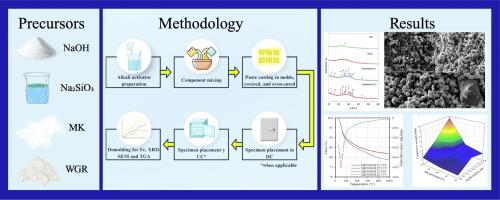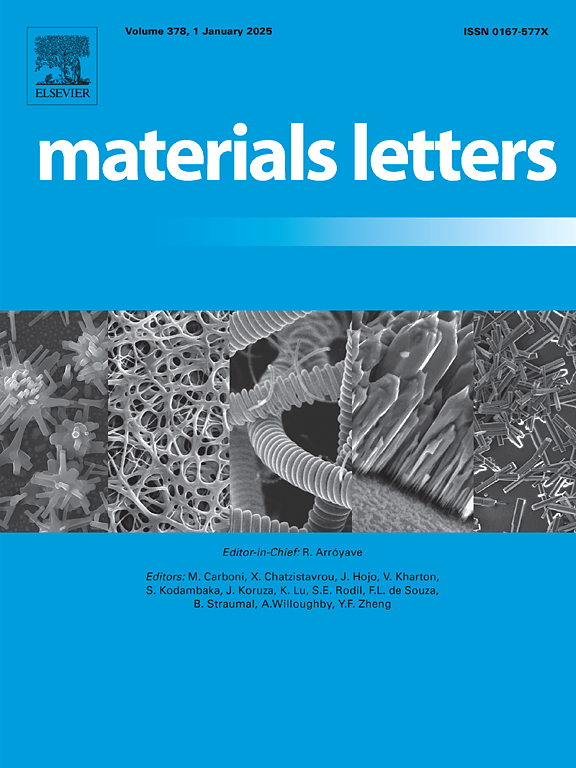二氧化碳固化对碱活化偏高岭土/废玻璃废弃物处理系统的影响
IF 2.7
4区 材料科学
Q3 MATERIALS SCIENCE, MULTIDISCIPLINARY
引用次数: 0
摘要
本研究采用NaOH和Na2SiO3∙5h2o碱性溶液,分析了碱活化偏高岭土/废玻璃在质量比为100:0、90:10和80:20时的性能,以提高前驱体的内部Si/Al比。样品经过了性能增强的加速碳化固化方案,并与未碳化的样品进行了比较。x射线衍射结果表明偏高岭土和废玻璃高度非晶化,导致铝硅酸盐凝胶本质上是非晶化的。暴露于CO2中可使抗压强度提高约40%,部分原因是由于额外的CaCO3沉淀造成的致密化。玻璃的加入对材料的力学性能有负面影响,而使用含Na2SiO3∙5h2o的活化剂对材料的力学性能影响很小。偏高岭土的高需水量导致了低尺寸稳定性,导致了高收缩应变,并通过添加玻璃来缓解。本文章由计算机程序翻译,如有差异,请以英文原文为准。

CO2 curing influence in alkali-activated Metakaolin/waste glass rejects systems
This study analyses the performance of alkali-activated metakaolin/waste glass rejects at mass ratios of 100:0, 90:10, and 80:20, to increase internal Si/Al ratios of the precursor, using NaOH and Na2SiO3∙5H2O-based alkaline solutions. The specimens underwent a performance-enhancing accelerated carbonation-based curing regimen and were compared to specimens left uncarbonated. X-ray diffraction results showed that metakaolin and waste glass were highly amorphous, which led to essentially non-crystalline aluminosilicate gels. Exposure to CO2 enhanced compressive strength by ∼40 % partly due to densification from additional CaCO3 precipitation. The materials' mechanical performance was negatively affected by glass addition, whereas minimal changes were observed from the use of Na2SiO3∙5H2O-containing activators. Low dimensional stability was observed due to extremely high water demand of metakaolin, leading to high shrinkage strains and mitigated by glass addition.
求助全文
通过发布文献求助,成功后即可免费获取论文全文。
去求助
来源期刊

Materials Letters
工程技术-材料科学:综合
CiteScore
5.60
自引率
3.30%
发文量
1948
审稿时长
50 days
期刊介绍:
Materials Letters has an open access mirror journal Materials Letters: X, sharing the same aims and scope, editorial team, submission system and rigorous peer review.
Materials Letters is dedicated to publishing novel, cutting edge reports of broad interest to the materials community. The journal provides a forum for materials scientists and engineers, physicists, and chemists to rapidly communicate on the most important topics in the field of materials.
Contributions include, but are not limited to, a variety of topics such as:
• Materials - Metals and alloys, amorphous solids, ceramics, composites, polymers, semiconductors
• Applications - Structural, opto-electronic, magnetic, medical, MEMS, sensors, smart
• Characterization - Analytical, microscopy, scanning probes, nanoscopic, optical, electrical, magnetic, acoustic, spectroscopic, diffraction
• Novel Materials - Micro and nanostructures (nanowires, nanotubes, nanoparticles), nanocomposites, thin films, superlattices, quantum dots.
• Processing - Crystal growth, thin film processing, sol-gel processing, mechanical processing, assembly, nanocrystalline processing.
• Properties - Mechanical, magnetic, optical, electrical, ferroelectric, thermal, interfacial, transport, thermodynamic
• Synthesis - Quenching, solid state, solidification, solution synthesis, vapor deposition, high pressure, explosive
 求助内容:
求助内容: 应助结果提醒方式:
应助结果提醒方式:


